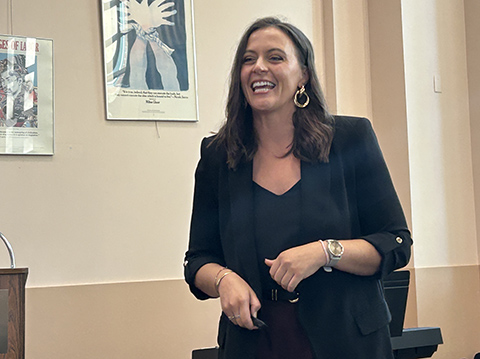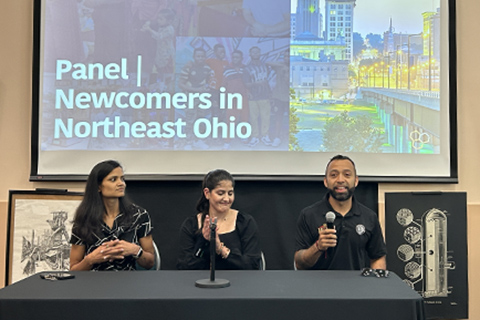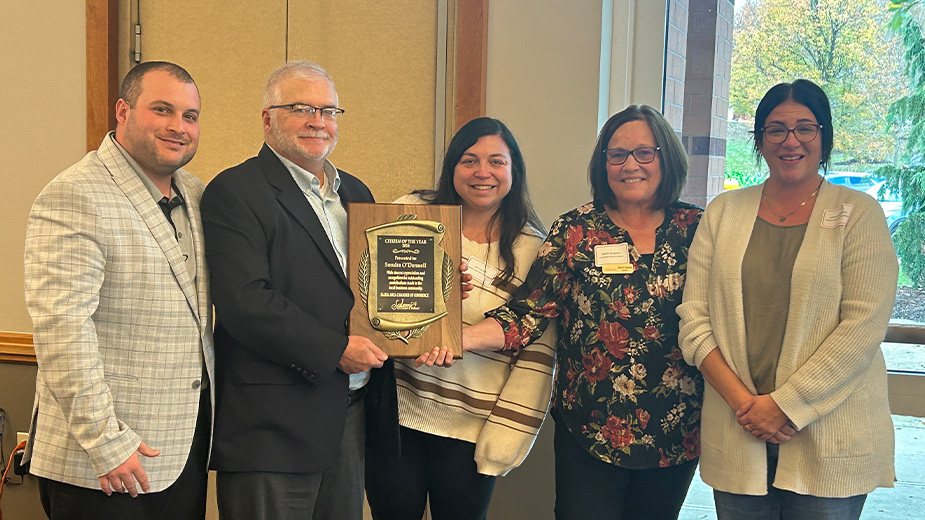Mapping Out How to Welcome Immigrants to the Valley’s Workforce
YOUNGSTOWN, Ohio – Jorge Carreño Valladolid came to Warren, Ohio, from Mexico City in 2003.
He didn’t know any English but a relative found him a job at a restaurant. Valladolid washed dishes, saved his money and learned English at night using a series of videos.
“I had a notebook, and I wrote things down and I took it with me,” the Girard resident says.
More than 20 years later, he owns a restaurant, Margherita’s Grille, and shares ownership of another, El Hefe, both in Girard.
Valladolid was one of three panelists at a Welcoming Immigrants in the Workforce event last month, part of Welcoming Week, presented by Thrive Mahoning Valley and the Community Foundation of the Mahoning Valley.
A Welcoming Workforce

Tanya Budler, founder and managing principal of Rise Together, told event attendees about the importance of thinking critically about the future and how to build a welcoming workforce “or a place where immigrants or international newcomers are not just here, but that they’re truly thriving in your community.”
Rise Together is a Cleveland impact consulting firm that partners with workforce, economic development and newcomer communities.
The labor market is tight, not just in northeastern Ohio or in the United States but across the globe, Budler says. She refers to a 2023 report from Korn Ferry, a consulting firm, that shows by 2030, the U.S. will be eight to 10 million workers short.
“That means for eight to 10 million jobs, there’s not a single person who could work those jobs living in the United States,” Budler says. “And if you’re an employer, you know that the cost of vacancy, of an unfilled role, really significantly impacts your bottom line.”
The projection is $1.7 trillion of unactualized revenue, or about 6% of the annual economy,” she says.
“Six percent, just gone because we don’t have enough workers,” Budler says. “So, this is not just a problem for us to talk about here in Mahoning Valley, but a problem that is affecting everyone. The urgency is very much there.”
Unfilled Jobs
Budler also references a report from Team NEO that shows 3,000 unfilled jobs in Mahoning County as of June 2024. Looking at the projections from Korn Ferry, that will double by 2030.
“And that is a big amount for your county to just have those jobs unfilled and not contributed to the workforce, whether it be production or services,” Budler says.
And birthrates have been declining for decades.
“Every single day for the next 19 years, 10,000 baby boomers will reach retirement age … but that means 10,000 people could leave the workforce per day in the United States for the next two decades, and we just don’t have the people who are going to fill in,” she says.
In Mahoning and Trumbull counties, the number of millennials is low for the counties’ sizes compared with national data. Plus, more people are retiring in those two counties compared with national data, Budler explains.
That’s why it’s important to talk about international newcomers, she says. It’s a term that includes asylees/humanitarian parolees, refugees, international students and immigrants. International newcomers have been and will continue to be, the only form of population growth in the United States, Budler says.
“So, newcomers really are the way that we are going to be able to maintain our communities, and it’s also quite wonderful that they’ll make our communities far more vibrant too,” she adds.
Recalling History
Welcoming international newcomers isn’t something new for the Mahoning Valley, Budler says, pointing to the number of immigrants who came to the area to work in the steel mills in the late 19th and early 20th centuries.
“The very foundation of this place is welcoming, and that alone should be something that you think about and you hold on to when you’re thinking about the future and how to welcome immigrants and newcomers into your workforce,” she says.
The Youngstown/Warren Regional Chamber and Eastgate Regional Council of Governments have been working for more than a year on a repopulation initiative aimed at filling existing high skill jobs as well as those forecast to be created in the region. Their focus is on the three Rs: retaining young people, returning those who have left the region and receiving newcomers.
“Here in the Mahoning Valley, you already have kind of a foot forward as well, because, as I understand, the chamber has been thinking about their population plan and newcomers and refugees being a portion of it, and how might you actually become a resettlement hub through certain organizations,” Budler says. “So that’s a very important step forward that you’re already moving.”
The Panelists
Valladolid, the Girard restaurant owner, was joined on the panel by two women who live in the Cleveland area, Melaak Rashid and Anshul Gupta.

Rashid is director of development at Smart Development, a nonprofit that serves refugee and immigrant populations.
She was born in the United States, but her parents are immigrants who came to Brooklyn from Venezuela but are originally from the Middle East. The family moved to Ohio because it was more affordable.
Gupta, a native of India, came to Cleveland and enrolled at Case Western Reserve University. She recently secured a job at a Cleveland hospital.
Valladolid, who learned to cook making tamales with his mother in Mexico and sold items at a flea market as a teenager in his home country, worked long hours at the restaurant. During his free time, he studied English.
He worked his way up in the Italian restaurant where he first got hired in Warren. He learned how to make pizza and to cook the other menu items and watched how the front of the restaurant operated.
His original plan was to save money and return to Mexico.
“I never dreamed I would own a business in the United States,” he says.
Change of Plans
But he met his wife who worked as a server at the restaurant.
Valladolid was ready to return to Mexico when he grew frustrated at work. His wife’s grandmother died and that delayed the trip. Then his father-in-law offered to help the couple fix up a building he owned and to provide the startup money for Valladolid to open a restaurant. One condition was that the business be named for his father-in-law’s late mother, Margherita. They opened the restaurant in 2007.
Valladolid acknowledges that he came to the United States illegally but says he’s legal now, has a work permit and is working to become a citizen. Because he entered this country illegally, getting married didn’t garner him citizenship.
His sister and her children have since immigrated to the United States — legally — and work in his restaurant.
“I have been able to bring 13 members of my family in the last two years,” he says.
Growing up, Valladolid didn’t have much direction and got into some trouble, he says. His mother is thrilled with how he’s changed.
“She’s very proud,” he says.
Pictured at top: Jorge Carreño Valladolid, the owner of Margherita’s Grille in Girard, came to the United States in 2003. He started working at a Warren restaurant as a dishwasher and worked his way up, learning English in his free time.
Copyright 2024 The Business Journal, Youngstown, Ohio.



